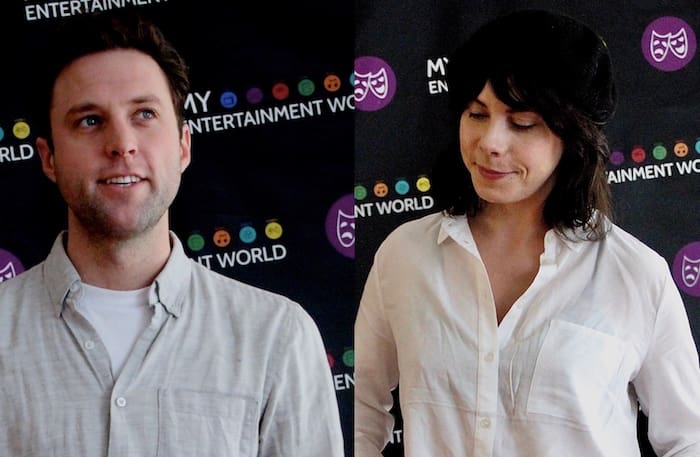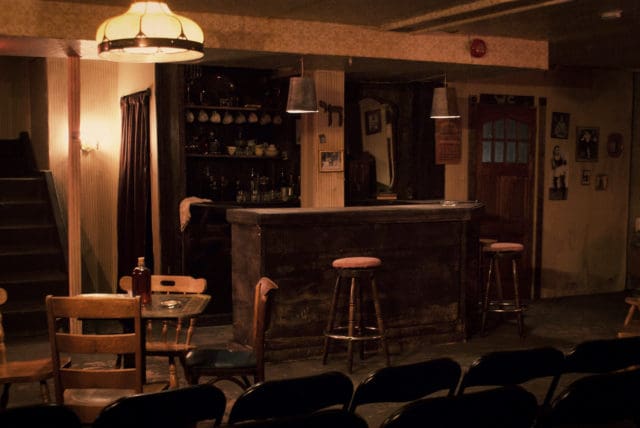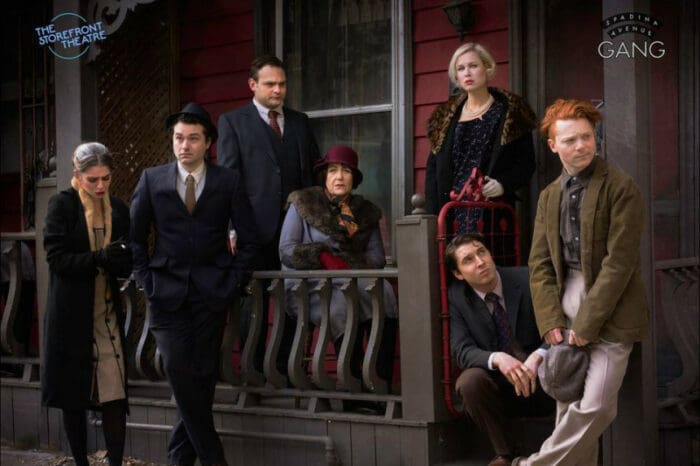 Before we announce the winners of the 2017 MyEntWorld Critics’ Pick Awards, we’re proud to present our annual Nominee Interview Series.
Before we announce the winners of the 2017 MyEntWorld Critics’ Pick Awards, we’re proud to present our annual Nominee Interview Series.
To say that the design team of Adam Belanger (set) and Lindsay Junkin (costumes) is formidable is a pretty big understatement. Both separately and together, they’ve completely redefined our conception of what indie theatre can look like, delivering production after production filled with extraordinary detail and ridiculous authenticity regardless of budget and space limitations. They’ve won Outstanding Set & Costume Design awards two years in a row and are nominated again this year for two different productions- Unit 102 Actor’s Company’s classroom three-hander Miss and The Storefront Theatre’s site-specific period piece Tough Jews. Adam took part in our group podcast interview about Miss (which included lots of discussion about Lindsay’s costumes) so we spent most of this interview talking about Tough Jews and the many challenges of designing that epic production.
Catch us up on your life since the last Interview Series.
LJ: There’s been so much, that’s an impossible question! I’ve been incredibly fortunate to have worked on a lot of shows over the last year and get to explore so many different worlds. It’s been a year of a lot of personal growth, getting to work with other theatre makers that I’ve admired for a long time and learning more about who I am as a designer.
AB: Since the last Interview Series, I have done three plays. Tough Jews, Miss- which we’ll talk about later- and The Late Henry Moss. I have also been continuing to work on Nirvana The Band The Show, which for now is on hiatus, because of Viceland going under. Just a hiatus. We are coming back. That’s pretty much been it, work-wise.
How did you get involved in Tough Jews? It’s a rare non-Unit 102 show.
LJ: Ben Blais [director] sent me a message one day about the production while they were working on applying for grants. He had seen Adam and my work in Unit 102 shows over the years and thought we were a great fit to make Tough Jews come to life in vivid detail.
AB: Well, the link was definitely Michael [Ross Albert, playwright], because I’d worked with Michael only once before, on a Next Stage play of his called For a Good Time, Call Kathy Blanchard. He gave me the play, and I read it, and I was also approached separately by Ben about it. So I knew that they both wanted me to work on it, and reading it, of course I was instantly interested, and started researching Kensington Market right away.
Did you sign up before the venue change, before the Storefront closed?
AB: Yes. I definitely thought it was going to happen there [in the theatre space on Bloor St. W]. We had lost Unit 102 [the old space on Dufferin] at that point, so that gave me some more time, because we would normally have done a play in the spring. But with not having a theatre, this was a perfect opportunity to continue working on something great. I wanted to work for the Storefront. I hadn’t worked with Ben before, or anyone from the company. So I was very interested, but I definitely thought that we were going to do it at that venue.

What were some of the challenges of Kensington Hall, once you moved there?
AB: [laughs] Fairly endless. I remember when we went and looked at it, everyone was very excited – Ben and Michael – I was trying to be optimistic, and open to the idea of working there, but I’m just looking around the room, and there was no risers. There’s no theatre there. It was just an empty basement. So I had to think as an audience member first, and then consider, also, how the staging would be.
That was only step one of all the complications. But there were things that were beneficial, like the fact that the play has two entrances, both which are staircases, written into it. That really made that venue absurdly perfect. [laughs] It would’ve been a lot of work for that, if I’d had to do that in the Storefront. But getting in there to actually build this basement inside of the basement – the first problem was making it a theatre first. Then just trying to make sure that all the sight lines are good, and then that we could also utilize some of the things that are in there without making it seem like we had no choice to. By that, I mean there’s a rough rock wall down there that was perfect. I was like, “Okay, if the set can just lead into this, then this can be an organic wall. That allows us to keep the staircase organically. And for this, I just have to make some set walls to cover this, so that this can go under the house”. I tried to make the set look seamless, so you have the experience of not walking onto a set. You’re walking into this basement. That is what we’re trying to make it look like. So I think that if I really achieved my job, it would look like everything was already there.
LJ: I think for the costumes department the biggest challenge was with when you have an untraditional theatre venue that can mean there isn’t necessarily some of the things you need. For instance, Tough Jews didn’t shy away from blood, which anyone who saw it knows intimately, so that was a lot of bloody costume laundry to have to do in a space that didn’t have a laundry machine. Luckily, friends in an adjacent building gave us access to the machines. Other than that, working in Kensington Hall was great and really helped create the world of the show.
The play was set in a real time in Toronto history. How much research went into recreating that?
LJ: For a period-specific design I often focus heavily on learning the cuts of garments that’s important to a period, as well as, the dominant textiles of different classes in the time frame. While in a show like Of Mice and Men, the costume breakdown was a big indicator of status, Tough Jews research focused on the time-specific appearances of affluence through accurate textures and garment trends.
AB: Quite a bit. I renewed my library card for this [laughs] I got some great books on Kensington Market, and it was really fascinating to read about the history of immigration, going from what was known as The Ward to Kensington Market, and having it converted from Victorian into Victorian houses that are also storefronts. The Jewish community are the ones that made it a commercial community, so having this story take place in what is also a store or shoe shop upstairs was really interesting.
The other really interesting thing about all the research was being able to look at all these buildings that are mentioned in so much of it. Some of them are exactly as they were, just a stone’s throw away from Kensington Hall. There’s this row of buildings with all these peak roofs, that are all the exact same as they were.
So I did a lot of research, and I did a lot of photo research, too, looking into anything that I could find of settings. There wasn’t a lot, but when you do see pictures of some of these rooms that were there, you really get the sense that they were very Victorian homes. So designing the set was kind of this mix, things like having very Victorian wallpaper and stuff that wouldn’t necessarily be organic to a Jewish home, but they’d maybe just left it, because they were making a speakeasy out of what they were given that was just an old Victorian home. The whole thing was very practical.

Lindsay, tell us about working with director Ben Blais to create the look of the characters.
LJ: Ben really wanted us to essentially create a production that looked as if at any moment one could take a photo and it would be as close in detail to an actual photo from that time period. Because the space the show was in was so intimate, that meant the detail work had to be as authentic as possible. Something we nodded to with our promotional photos.
Adam, working in a space that wasn’t already set up as a theatre space, how much did you have to work with Ben to determine what was going to be the playing space, versus the audience space, and how the movement needed to be facilitated by the set?
AB: It’s often a chicken before the egg situation, where I’ll come and be like, “These are the designs that I have, or what I’m thinking.” And then they’ll kind of share with me – “This is the blocking that we’ve been thinking”. I’m usually pretty good now at making sure that [conversation happens] very early, so we don’t get locked into whatever the blocking is. Because that can happen, where it’s like, “Oh, the actors have already been pretending there’s a door right here, so there’s gonna have to be a door here. They’ll freak out if there’s no door here.” [laughs] But luckily, with this space, the staircases are there. So we were really there together kind of saying “Okay, this could be the bar, and this could be here”. Ben’s very enthusiastic and positive, so when I showed him the layout, he was very excited about it, and we just taped it off, right away, in the rehearsal space. And they were able to just pretend.
Did you have any big ideas that were edited out for practical reasons?
LJ: We had to replace a costume or two because of the use of stage blood getting on actual period clothing. Items from that time are obviously delicate just from natural breakdown but often made in fabrics that would be more susceptible to damage from stage blood. So unfortunately, a few costumes got changed after including the stage blood to remove the possibility of them getting ruined.
What was your favourite element of the design?
LJ: My favourite design element was actually the passage of time between the first act and the second. We got to include a lot of visual references to how the world was changing at that time and the impact it had on individuals. There was economic struggles, women’s rights progress and political shifts that were beautifully incorporated by Michael, which gave me a lot of rich text to draw on.
AB: The wallpaper on the ceiling. Because I very rarely get to incorporate the ceiling, because there’s a lighting grid, and it’s very neutral. You don’t think about it. But being in a space with low ceilings, and being able to have practical- like a chandelier hanging from a ceiling. Having another wall of the set was exciting, because you don’t usually get that opportunity.
Were you pleased with how the design worked in practice?
LJ: I was incredibly happy with how the designs worked in practice. The actors really leaned in to the historic pieces and really helped ground the costumes in the staged reality of the show.
Do you have a favourite moment in the production?
LJ: I don’t necessarily have a favourite moment in the play, there are so many wonderful moving parts to it and such beautiful acting, that different moments always resonated with me at different times. I will say though that any time we saw the relationship between Ida (played by Theresa Tova) and her daughter Rose (played by Maaor Ziv) on stage, I was enthralled. I’m a big fan of how Michael writes women and those two characters really struck me with their societal fragility and personal ferocity.
What are you doing now/ what’s your next project?
LJ: I just opened Outside The March’s and Company Theatre’s co-pro of Jerusalem, which I did costume design on. It was a show so long in the making and large in scope that I’m excited to take a bit of time off and recharge my creative batteries. I’m so proud of how this production and the design has grown that I’m going to rest on my laurels for a bit before I go looking for my next challenge.
Do you have anything you’d like to add?
LJ: I’m so thankful that Tough Jews has gotten so much recognition over the last year. Everyone worked so hard on it and it really was a special show for me. Miss as well, was such an accomplishment and it’s always nice to go “home” to Unit 102 where I got my start.
